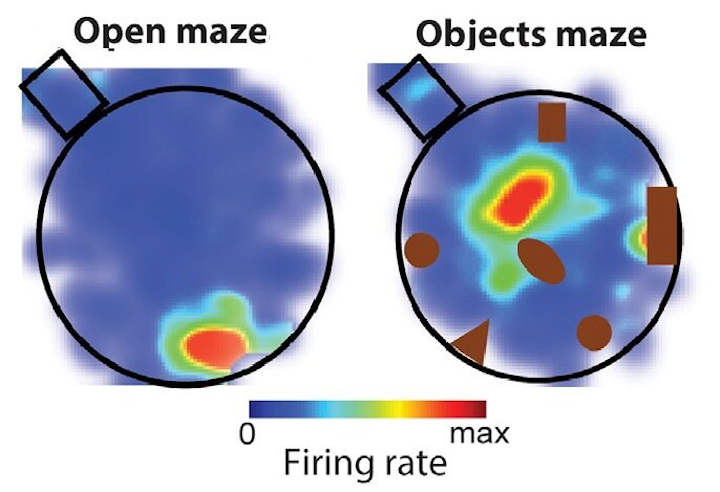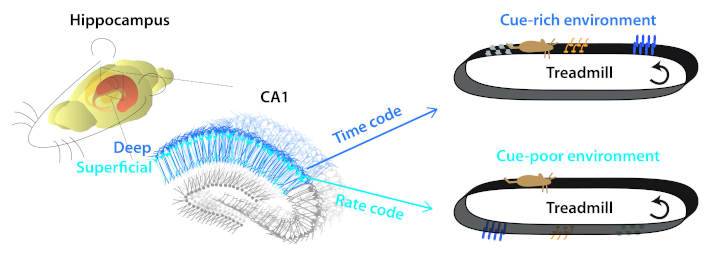Pyramidal neurons in the hippocampus inscribe spatial information using two interchangeable information processing methods referred to as a rate code and a phase code, that can be roughly compared to the number and spatial arrangement of bar codes, The Korea Institute of Science and Technology (KIST) reports.
The research team, led by Sebastien Royer at KIST Brain Science Institute (BSI), in collaboration with a research team at New York University (NYU), also found that parallel neural circuits and information processing mechanisms are used depending on the complexity of the landmarks along the path.
The study1 conducted two types of spatial exploration experiments. In the first type of experiment, the researchers used a treadmill with a long belt in a well-controlled spatial environment for mice, and trained the animals to run on the belt sequentially through a section cleared of any objects and another section furnished with small objects.
The second type of experiment was conducted with rats foraging in a circular arena that was either completely empty or filled with objects. To analyze neural activity, they implanted silicon probe electrodes in CA1, the subregion generating the main output of the hippocampus, and in CA3, a subregion of the hippocampus suspected of playing an important role in spatial memory formation.
Neural Navigation System
Finding routes to destinations and remembering special places are both controlled by a brain region that functions like a GPS navigation system. When taking a new path for the first time, people pay attention to the landmarks along the way.
Owing to this neural navigation system, it becomes easier to find destinations along the path once it has been navigated. Based on a variety of animal experiments, scientists have learned that cells in the hippocampus are responsible for spatial perception and are activated in discrete positions of the environment, for which reason they are called place cells.
However, how place cells, a type of pyramidal neuron, store long-term memories of locations and encode particular positions in the environment is still not understood.
Rates Code vs. Phase Code
The current two experiments found that the hippocampus uses different neural circuits and information processing strategies depending on the environmental conditions. In the object-free environments, a group of cells located in the superficial region of CA1 tends to be active and uses a rate code since the animal position is best predicted by changes in the frequency of action potentials discharged by single neurons.

In contrast, in a complex, object-strewn environment, a group of cells in the deep region of CA1 tend to be active and uses a phase code since the animal position is best predicted by the timing of a neuron action potentials relative to the ensemble of active neurons.
The findings suggest that the circuit using the rate code is more strongly associated with providing information about overall positioning and spatial perception, whereas the circuit using the phase code is more strongly associated with remembering the precise location of an object and spatial relationships.
Aside from this, the respective contribution of inputs from CA3 and the entorhinal cortex was also analyzed. It is known that the CA1 subregion receives information from both the CA3 region and the entorhinal cortex.
Deep And Superficial CA1 Cells
In this study, based on differences in fast network gamma oscillations, the researchers found that superficial CA1 cells receive information primarily from CA3 in the simple environments, whereas deep CA1 cells receive information primarily from the entorhinal cortex in the complex environments.
This study improves our understanding about how the hippocampus processes information, which is a critical step for understanding the general mechanisms of memory. Such basic-level understanding will eventually help the development of technologies for the diagnosis and treatment of brain disorders related to hippocampal injury such as Alzheimer’s dementia, amnesia, and cognitive impairment, and might inspire the development of some AI,
said Sebastien Royer, principal investigator at KIST.
- Farnaz Sharif et al. Subcircuits of Deep and Superficial CA1 Place Cells Support Efficient Spatial Coding across Heterogeneous Environments. Neuron (2020). DOI: 10.1016/j.neuron.2020.10.034 ↩︎
Last Updated on October 3, 2022
